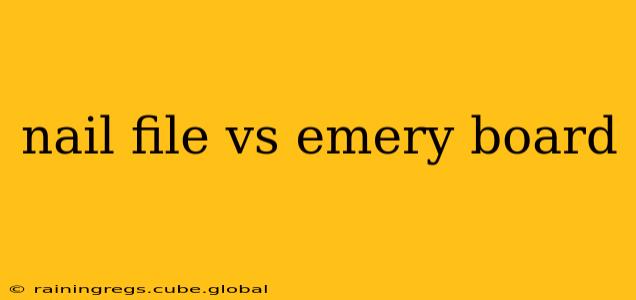Choosing between a nail file and an emery board might seem trivial, but understanding the differences can significantly impact the health and appearance of your nails. Both tools are used for shaping and smoothing nails, but their construction and effectiveness vary, leading to different applications and results. This comprehensive guide will delve into the specifics, helping you determine which is the best choice for your needs.
What is a Nail File?
Nail files are tools designed to shape and smooth nails. They come in various materials, grits (coarseness), and shapes. Common materials include metal, glass, and various types of abrasive material bonded to a flexible base. Metal files, while durable, can be harsh on nails if not used carefully. Glass files are gentler and often preferred by nail technicians for their smoothness and longevity. The grit of the file determines its abrasiveness; a lower grit (e.g., 80 grit) is coarser and better for shaping, while a higher grit (e.g., 180 grit) is finer and ideal for smoothing and buffing.
What is an Emery Board?
An emery board, also known as an emery board file, is a specific type of nail file. It's typically made from a thin piece of cardboard or wood coated with an abrasive material, usually emery. Emery boards are disposable and generally less expensive than other types of nail files. They are often characterized by their relatively coarse grit, making them effective for shaping but potentially less suitable for delicate smoothing.
What are the Key Differences Between a Nail File and an Emery Board?
The primary difference lies in the material and construction. While an emery board is a specific type of nail file, nail files encompass a much broader category. This means nail files offer a wider range of materials (metal, glass, etc.), grits, and durability. Emery boards are usually disposable and less durable, while other nail files can last for a much longer time.
H2: What's the best nail file for weak nails?
For weak or brittle nails, a glass file or a high-grit (fine) nail file is recommended. These gentler options minimize damage and breakage. Avoid using metal files or coarse-grit emery boards on weak nails. Focus on gentle shaping and smoothing rather than aggressive filing.
H2: Are metal nail files bad for your nails?
Metal nail files can be bad for your nails if used improperly or excessively. Their sharp edges can cause splitting and tearing, particularly if you use too much pressure or file in one direction only. However, when used correctly and with the appropriate technique (gentle strokes in one direction, frequent swapping of directions), they can be effective and long-lasting.
H2: Which is better for shaping nails?
For initial shaping, a coarser-grit nail file (lower number) or an emery board is typically suitable. However, always finish with a finer-grit file for a smoother, more polished look. Using only a coarse grit can leave nails rough and prone to damage.
H2: How do I choose the right grit for my nails?
The ideal grit depends on your needs and nail condition. Lower grits (e.g., 80-100 grit) are best for shaping and removing significant length. Medium grits (e.g., 150-180 grit) are good for general shaping and smoothing. High grits (e.g., 200+ grit) are ideal for buffing and creating a high shine.
H2: Can I use an emery board on acrylic nails?
Emery boards are generally not recommended for acrylic nails due to their relatively coarse grit. This could damage the acrylic surface, leading to unevenness or chipping. For acrylic nails, professional tools and techniques are recommended.
Conclusion:
Ultimately, the best choice between a nail file and an emery board depends on your individual preferences and needs. Emery boards are convenient and affordable for occasional use, but for regular manicures or for those with weak nails, a higher-quality nail file made of glass or with a finer grit is a superior investment in long-term nail health. Remember to always file in one direction to avoid causing damage and splitting, and choose the right grit for the task at hand.
